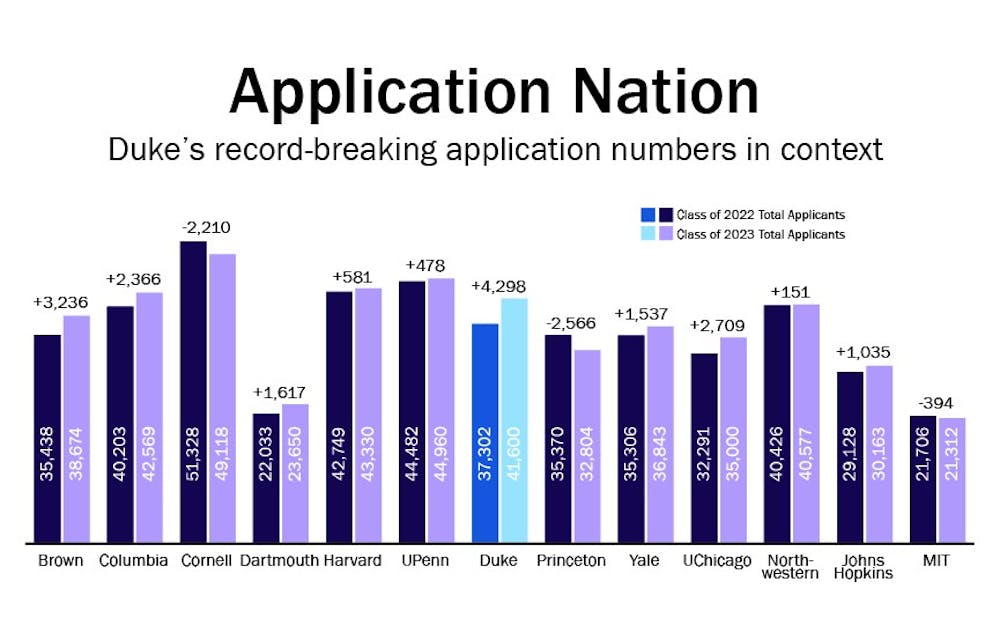In recent years, many higher education institutions have seen an uptick in applicants and a decrease in acceptance rate. But this year is an exception for some elite universities.
For the Class of 2023, Duke had a larger increase in applications—around 4,300—compared to all Ivy League schools, the University of Chicago, Massachusetts Institute of Technology, Northwestern University and Johns Hopkins University. Princeton University experienced a decrease of 2,566 applications, and Cornell had 2,210 fewer applicants.
Duke also reported record lows for both early and regular admittance, with an 18.2% early acceptance rate and a 5.7% regular acceptance rate. The year before, 21.4% of early applicants were admitted, and 6.4% were accepted regular decision.
Christoph Guttentag, Duke's dean of undergraduate admissions, said in 2018 that the number of early decision applications the University received for the Class of 2023 was the largest one-year increase that Duke has recorded.
"We were struck by the talents and accomplishments of so many of the students who applied this year, and had a difficult time choosing from among them," Guttentag said in a Duke Today release about the early decision acceptees.
Duke has now broken its record for number of applications received for the fifth year in a row. In a 2018 interview with The Chronicle, Steve Nowicki, then dean and vice provost for undergraduate education, attributed this increase to students being able to apply to many schools on the Common Application.
He said that this practice creates a positive feedback loop that gives rise to more applications submitted to highly selective schools, causing acceptance rates to drop. This causes anxious students to apply to more schools.
This trend is prevalent at other top universities. Ranked first by the U.S. News and World Report, Princeton received 32,804 single-choice early action and regular decision applications for the Class of 2023. It admitted 13.9% of early admissions applicants into the Class of 2023, compared to 14.7% the year before. In 2011, the first year that Princeton reinstated an early admission program, it admitted 21.1% of early admissions applicants.
Harvard had similarly declining admission rates. Its restrictive early action rate decreased to 13.4% for the Class of 2023 from 14.5% the year before. Its first-year applications increased from 42,749 to 43,330.
Applications to Columbia's Class of 2023 increased by more than 2,000 from last year's matriculating class, increasing from 40,203 to 42,569. Columbia admitted 14.6% of early decision applicants and 4.0% of regular decision applicants.
The Class of 2023 at University of Chicago had a record number of applications at just under 35,000–increasing by nearly 3,000—resulting in its most selective overall admissions rate of 5.9%.
Tied eighth with Duke in the U.S. News rankings, the University of Pennsylvania saw a decline of just less than 4% than in its early decision rate from last year’s 18.55%. The University of Pennsylvania admitted 3,345 from nearly 45,000 applications this year.
However, some other peer institutions saw increases in their acceptance rates.
Northwestern had an increase in its overall acceptance rate for the first time in a decade from 8.4% to 8.9% this year.
Experiencing an uptick of more than 1,000 applications, Yale had an increase in its regular decision admission rate, going from 6.27% to 6.91%. The restrictive early action rate, on the other hand, declined from 14.7% to 13.2%.
MIT's early action rate increased from 6.9% to 7.3%, and its applications increased from 20,247 to 21,312.
Meanwhile, Johns Hopkins saw an increase in its early decision rate from 30% to 31% and an uptick of slightly greater than 1,000 applications for the Class of 2023.
Johns Hopkins' Class of 2023 will be the first to matriculate after Michael Bloomberg’s $1.8 billion donation in November of last year. These students will be eligible for scholarships since the university will no longer offer financial aid packages that include student loans.
Correction: An earlier version of this story cited Yale's early decision rate. It has been corrected to describe it as the restricted early action rate. The Chronicle regrets the error.
Get The Chronicle straight to your inbox
Signup for our weekly newsletter. Cancel at any time.

